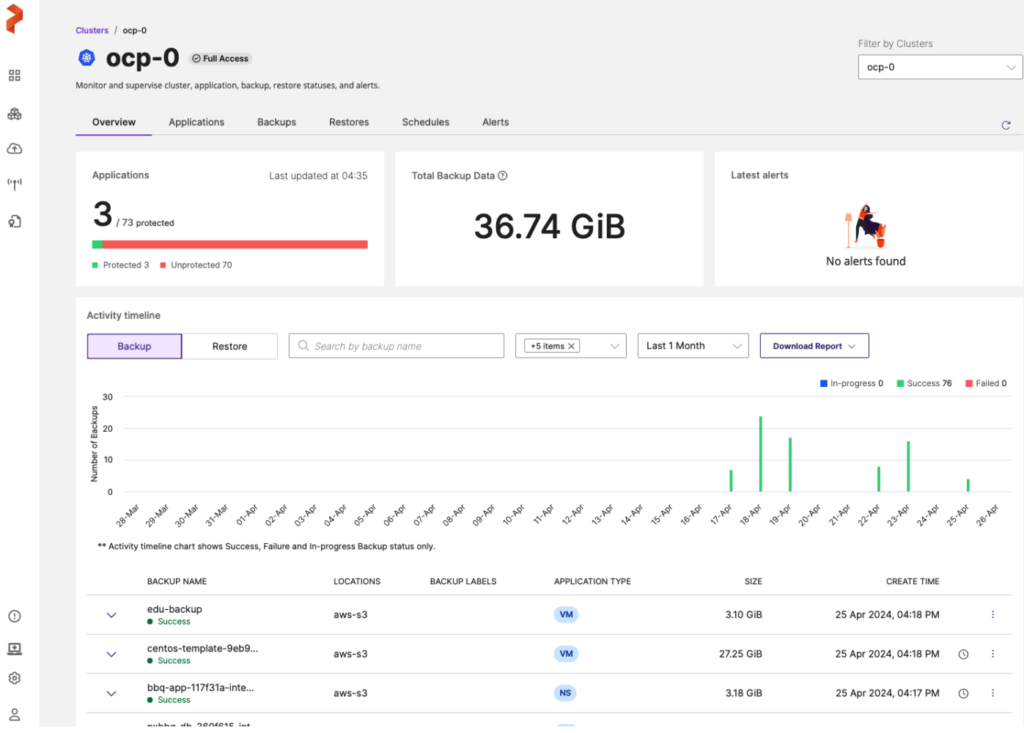New KubeVirt-Focused Dashboards in Portworx Backup
Portworx Backup 2.7 is now available, featuring a new user interface designed specifically for managing backup and restore of stateful Kubernetes data, including KubeVirt-based virtual machines. Unlike previous versions, which primarily supported container-based workloads, this update responds to the growing demand for effective Kubernetes-based virtual machine solutions by simplifying the management of VMs in KubeVirt and OpenShift Virtualization clusters.
The updated dashboards provide a quick glimpse at what’s going on within your Kubernetes clusters. Administrators are able to view the details of a specific cluster, or they can review the backup and restore operations of multiple clusters that have been registered with Portworx Backup. The protected, and unprotected applications counts can be viewed, as well as the cumulative total of backup data that is stored and of course any alerts that should be reviewed such as a failed backup or restore. The activity timeline lets you see how many backups are taken per hour and whether those backups were successful or not.

A quick change to the restore tab will show a similar timeline for any restores that have occurred which is an important metric for Administrators to use if they’ve given self-service access to DevOps teams. The self-service capabilities are a core function of Portworx-Backup, allowing DevOps teams to have access to not only certain namespaces within a cluster, but also specific backups used for pre-initializing things like databases with test data.
The central dashboard of course has a complete list of backups/restores that can be drilled into to find information about those tasks.

If backup administrators need to provide reporting to others within the organization, these backup and restore jobs can be exported to a PDF or CSV to be shared.

The enhanced interface enables Platform Engineers and Kubernetes Administrators to tailor the display of resources. For instance, in many of the screens, selecting the “VM” tab reveals only KubeVirt Virtual Machine Instances (VMIs), allowing virtual machine administrators to concentrate on their specific responsibilities and easily exclude container-based workloads. Additional filters for name, namespace, or namespace labels further streamline the management process as they have from previous iterations of Portworx Backup. The interface also allows administrators to filter restorations and schedules based on the type of workload being used.

Backing up a Virtual Machine Instance is now more intuitive, with a form that prompts users to input critical details such as the backup’s descriptive name and the backup location, which supports both Object and File-based storage. Administrators will also need to match Volume Snapshot Classes with the correct CSI Provisioner to properly take CSI based snapshots. There’s also an option to offload CSI snapshots to an external backup location, enhancing recovery options if the Kubernetes cluster goes offline—a practice in line with the 3-2-1 backup strategy. You can also make these backups ad-hoc, or as part of a schedule so that it’s taken automatically on a regular cadence.
While default settings automatically quiesce the VMI filesystem through the QEMU process, users can override this process by using their own pre-exec and post-exec rules.

Don’t worry, this release retains Portworx’s robust Kubernetes data protection features, allowing backups of Pods, Services, ConfigMaps, PersistentVolumes, Secrets, and more. From the new UI, the “NS” tab facilitates backup jobs based on Kubernetes namespaces, automatically including all relevant resources within the selected namespace—including the persistent data in PVs/PVCs as well as the Kubernetes metadata about the resources deployed.

When using a namespace backup methodology, Administrators can also backup Virtual Machine Instances instead directly backing them up from the “VM” tab as outlined earlier. Using a namespace backup may be useful if your application consists of both VMs and containers, making it simple to protect all the resources that are part of your applications. Be aware that the Pre/Post Exec rules that quiesce a VM filesystem will not be used in a namespace based backup unless specifically configured. Users also have the option to filter what types of resources are being backed up when using a namespace backup methodology.

As virtual machine based or traditional Kubernetes backup jobs are run, they can be viewed from the dashboard to monitor the status of those backup jobs and of course to be restored later.

When restoring a virtual machine to the cluster, you have the option to transform the configuration of your Kubernetes based workloads. First, if your backup was offloaded to the backup location, you can restore the backup to a different cluster than where it originated. For KubeVirt based VM backups, this does require that the new cluster has similar features such as KubeVirt deployed in the new cluster. This option might be used for migrating workloads between clusters as we’ve done for many years with container-based resources. Regardless of what cluster your resource is being restored to, Administrators can also perform resource re-mapping so you can change the storage class associated with the VM as well as the namespace. The Portworx Backup tool is often used to modify existing resources by restoring pods or virtual machines to the same cluster but in a different namespace with a different portworx-storage class assigned.

With the latest release of Portworx Backup 2.7, Kubernetes administrators attempting to Unify their Virtual Machine and Container workloads into a single platform can use Portworx backup to protect the entire estate, providing a single tool to manage your platform.
If you’d like to learn more about how Portworx can help you manage your virtual machine instances running in Kubernetes and their data, visit https://portworx.com/modern-virtualization/
And if you’d like to try out Portworx Backup yourself, sign up for our free trial here. https://portworx.com/services/backup-and-data-protection/backup-free-trial/
Share
Subscribe for Updates
About Us
Portworx is the leader in cloud native storage for containers.
Thanks for subscribing!

Eric Shanks
Principal Technical Marketing ManagerExplore Related Content:
- backup
- data protection
- Modern Virtualization

Accelerate data services deployment on Kubernetes using Portworx Data Services






